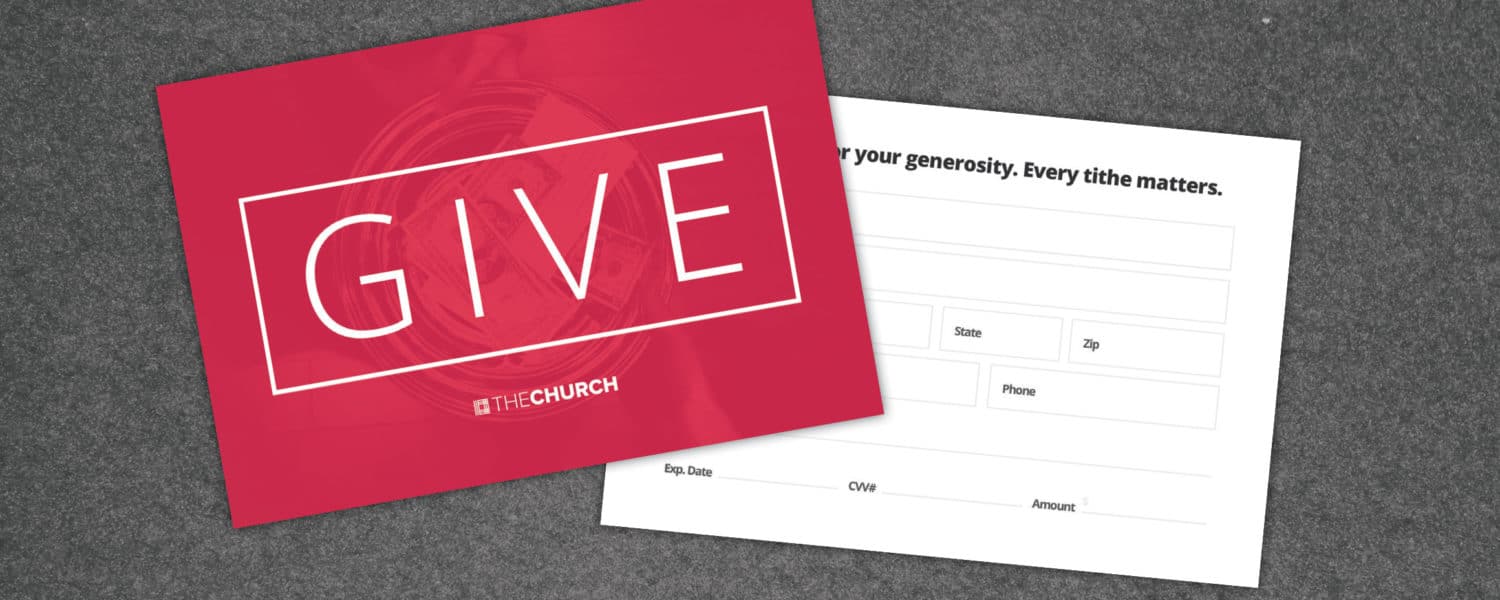By Ken Sloane
As I speak with leaders across the church, I’ve heard a lot of frustration and weariness. Leading in the area of stewardship and finance has been a rollercoaster ride. Panic and anxiety in March and April, some hopefulness in June and July (fewer people away during the summer months).
As we move into the fall, the questions about annual campaigns and trying to imagine a budget for the unpredictable year ahead have raised anxiety levels once again. “How can we do an annual campaign in the midst of a global pandemic that might get worse before it gets better? Should we just forget about a campaign this year and hope for the best?”
Well, we can agree the old normal is gone – we are in a new place. You probably can’t do the same kind of campaign you did last year, but that may not be enough reason to sit this one out.
An annual campaign does more – should do more – than just raise money for the budget. It should be a time to share a vision for mission and ministry in your community and around the world. It is a time to make a case for the difference the generosity of your congregation can make when they give.
If you skip an annual campaign this year, you risk leaving people with the impression that it really isn’t important. It will no doubt be different, but it can be an effective way to have people focus on what the church means to them and to the community…and on all the blessings that make their hearts grateful to God. For many people, the annual campaign is one of the few places where they can reflect on what their local church means to them, to the community, and to the world.
No, your campaign won’t look like last year, and maybe not much else will look like last year. You can, though, do something new.
WHERE HAVE YOU MADE AN IMAPCT?
In my conversations with people in the last six months, they have heard one refrain, over and over: “Your building may be closed; the church isn’t!” This should continue to be the theme communicated to church members and the community. The farther people are from the center of church activity and planning, the easier it is to think that if the building isn’t in use, the church is on hiatus.
The church I attend did a two-month worship series this summer on “The Church Scattered.” It reminded us that sometimes we are the church gathered; however, most of the time (167 hours per week, we were constantly reminded), we are the church scattered. We are still the church, even when we are scattered. Be sure your campaign includes stories of where God’s love has been made real by the church scattered, especially during the last six months.
WHERE ARE THE CONNECTIONS?
Throughout the days since church buildings had to close as part of sheltering at home against the COVID-19 virus, we have seen countless examples of the benefit in keeping people connected— Zoom calls just to see familiar faces; texts to check in on loved ones or asking people if they need anything from the store. Congregations that had barely adopted the technology of email were all of a sudden streaming worship services on Facebook and YouTube to keep their people connected.
They were not all perfect, but they were keeping connected. In many cases, people were finding that the church was not just connected with those who had already been coming to church but with new people…and, in some cases, with people who had stopped coming for a variety of reasons. Pastors who knew that their members expected an in-person visit were discovering that now a text or a phone call was greatly appreciated. We began to realize that in these pandemic days, most of us value connection over perfection. Keep this in mind as you brainstorm how your 2020 annual campaign might look.
Planning a 2020 annual campaign way can be a great opportunity to keep people connected to the church and its mission, and to each other. Don’t miss this opportunity.
“HOME MEETINGS” CAMPAIGN MODEL MIGHT BE THE WAY
Many of us in the past have been used campaign models centered around events like congregational meals, visitations, or large worship services where the faithful bring pledge cards to the altar. One of the less frequently used models incorporates all the members of the church family being invited into a variety of homes for fellowship and to hear about the ministry plans for the church in the days ahead, with an invitation to make a financial commitment.
This last model is easily adaptable to our present circumstance by substituting Zoom meetings (or other videoconferencing options) hosted by members of the campaign leadership team for folks opening their homes. For those who don’t have smartphones or computers with video cameras, the church can provide provisions for dial-in. Limit the number of people in each gathering to the number who can be displayed on one screen (25 usually). The pastor can join each group, or if that’s not possible, she/he can assign a campaign team member and perhaps record a video message to be shared with each group.
TELL YOUR STORY, BUT ALSO LISTEN
If you incorporate the idea of the group meetings as part of your 2020 campaign strategy, be sure that you not only tell the story of how your congregation has been living out its mission during the pandemic, but also include time to listen intently to those present. Develop a list of questions for participants to answer, such as “Are you aware of places where we need to be reaching people and we are not?” Solicit community-wide needs. If people mention needs that your church is not equipped to address, determine if there are other groups better suited with whom your church could partner or support. You might ask people if they have felt connected and supported through the pandemic by the church. Are there ways that virtual worship could be more engaging?
THEME WORSHIP SERVICES TO CAMPAIGN
Just as you would have done in an annual campaign in the “pre-Corona days,” develop a theme for your worship that ties to your campaign. Plan a series of services and sermons that build interest and excitement about the campaign. Invite key leaders in the congregation to record short videos that connect to your campaign theme.
DON’T RULE OUT EXISTING CAMPAIGN RESOURCES
While all the elements of a pre-packaged campaign may not be adaptable for the current challenges, much of what is in these packages can be used. Most of the campaign materials offered include study resources or themed devotionals, along with worship resources, sermon suggestions, and sample communications resources. All those can be adapted for use this year.
PLEDGE/ESTIMATE OF GIVING CARD
Instead of using a printed, mail-in pledge card, have someone with the skill make a fillable PDF pledge card that can be emailed for people to complete and email back to the church. You may also want to consider if this is the best time to have your folks complete their Estimate of Giving card. One pastor I spoke with was doing the campaign, but not soliciting completed cards until January, when the uncertainty of the national election will be past and a view for a way beyond COVID-19 might be more in view.
Remember, this is a great time to encourage more members to sign up for secure, recurring, electronic giving!
BE SENSITIVE TO ECONOMIC HARDSHIPS
One of the most important considerations in planning a campaign during this time of pandemic is to be sensitive to those who are going through trauma in many forms: illness of family members or loss of loved ones; loss of income due to loss of business, furlough, or elimination of jobs. By simply including in your communication a phrase such as, “We are aware that some of you have been severely impacted by the current crisis and may not be in a position to increase your giving or even continue to give at last year’s level. Whatever you are able to do is a great blessing as we continue in ministry.” Be extra vigilant in reviewing prepared materials to catch anything that implies that “everyone can increase giving.”
BE BOLD IN INVITING SOME TO “STEP UP”
On the other hand, you also might be bold enough to challenge those who have not felt the economic crunch of this past year. No doubt there are those who have continued to work and receive their pay, who are working from their homes and not commuting and filling cars with gas every week, not eating out as often or buying work clothes as often. They are not paying off a vacation or planning one in the near future and experiencing that savings. In addition to all this, they may have received a stimulus payment on top! Find the wording that works in your context, but consider something like this: “If some of you have come through this pandemic time without too much economic turmoil, and if your find your way to step-up giving, knowing that others in this body are struggling, it would be deeply appreciated by your finance team.”
BEGIN AND END WITH GRATITUDE
Most important, begin and end every step, every email, every sermon, every tweet with “thank you.” Thank you for sticking with us through these tough times. Thank you for embracing ways of giving when we are not gathering every Sunday. Thank you for the random acts of kindness you are doing for your neighbors. Thank you for tuning in each Sunday morning and offering kind words of encouragement to those of us trying to make the technology work. Thank you for participating in Zoom meetings – they can get tiresome, but some of us just needed to see your face. Thank you for wearing a mask to keep the rest of us safe. Most of all, thank you for believing that even if our building is closed, we are the church and we are open for the business of love, compassion, and hope.
Ken Sloane is the director of Stewardship and Connectional Ministries at Discipleship Ministries for the United Methodist Church, www.umcdiscipleship.org.







